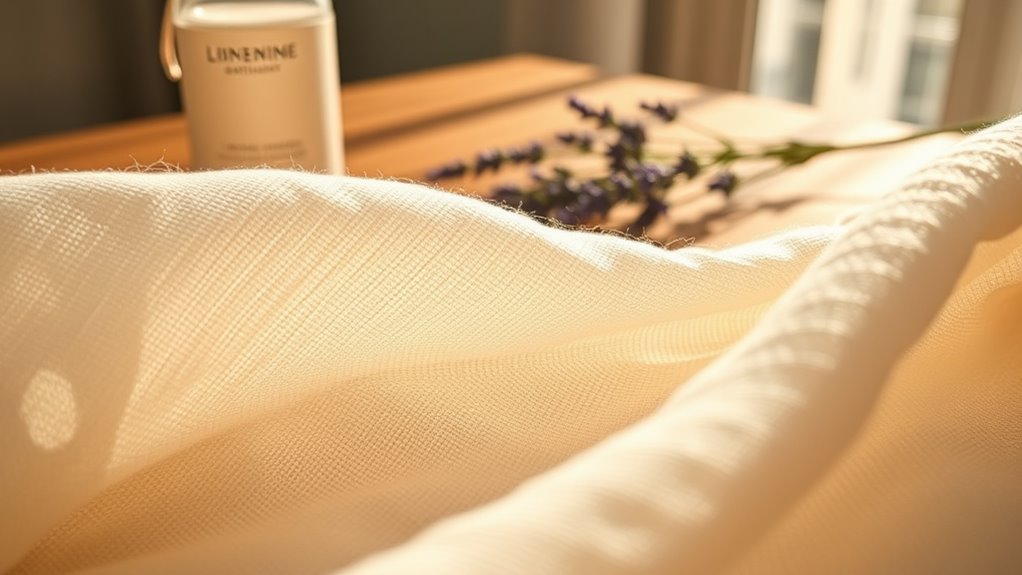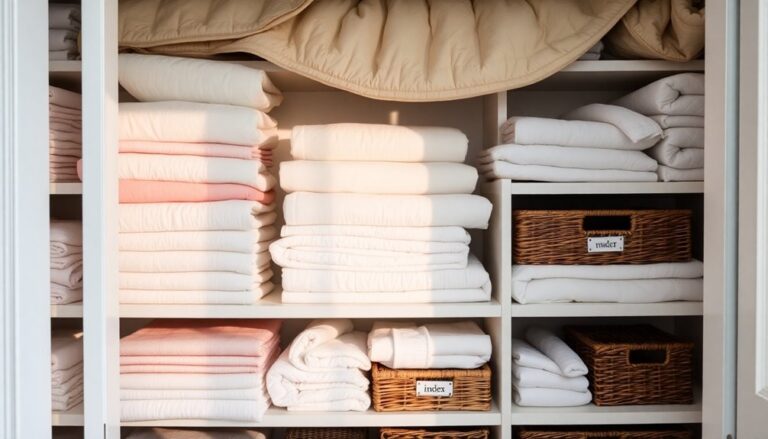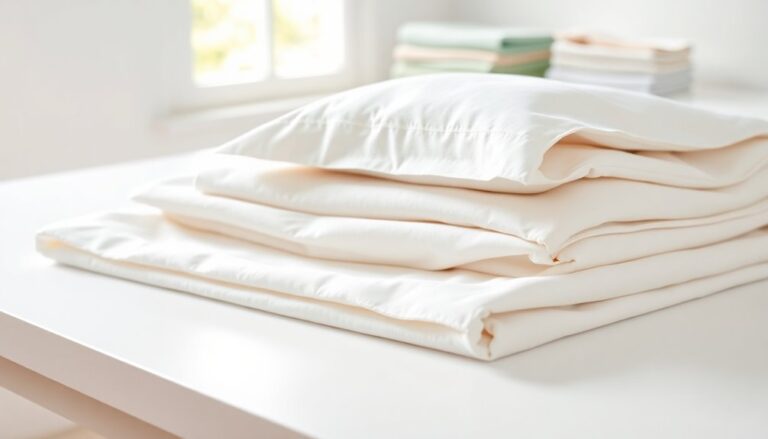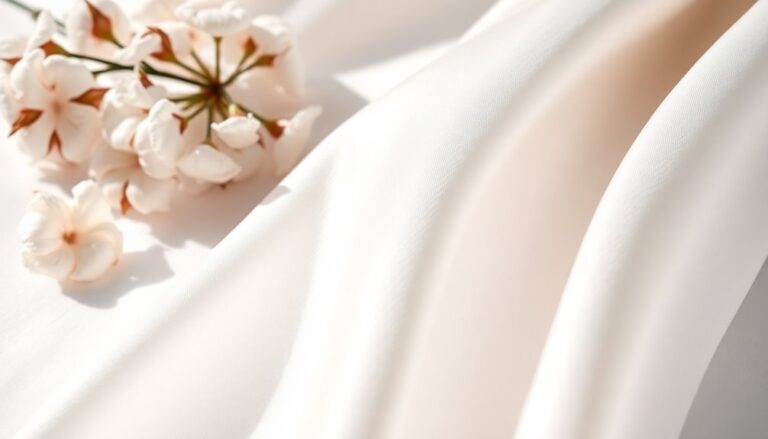Linen care's crucial for maintaining its beauty and longevity. It's a durable, eco-friendly fabric but requires gentle washing at 30 to 40 degrees Celsius. Air drying's best to prevent damage, whereas slightly damp fabric makes ironing easier. Stains need prompt attention, and storing linen in a cool, dry place guarantees it stays pristine. With the right techniques, anyone can revitalize old linen or address issues. There's much more to learn about perfecting linen care techniques.
Article Highlights
- Wash linen in warm water (30-40°C) with gentle, eco-friendly detergents to maintain fabric quality and prevent damage.
- Air dry linen to avoid heat damage, or tumble dry on low to prevent shrinkage and preserve color.
- Iron linen while slightly damp using high heat and smooth strokes to maintain its fresh appearance and texture.
- Store linen in a cool, dry place using breathable materials to prevent moisture buildup and preserve integrity.
- Regularly clean and rotate linen items to extend their lifespan and keep them looking pristine for future use.
Understanding Linen: Properties and Benefits

Linen, a timeless fabric derived from the flax plant, boasts unique properties that set it apart from other textiles. Its durability is one of its standout features; linen can withstand repeated washing and wear, often becoming softer and more comfortable over time. This resilience means it lasts longer than many synthetic fabrics, making it a smart investment for those seeking quality. Moreover, linen is celebrated for its sustainability. Flax cultivation requires less water and fewer pesticides than cotton, reducing its environmental impact. As a natural fiber, linen is biodegradable, reinforcing its eco-friendly appeal. Together, linen durability and sustainability make it a desirable choice for conscientious consumers looking to combine style with environmental responsibility.
Washing Linen: Best Practices
When washing linen, it's essential to take into account the ideal water temperature for maintaining its integrity. Selecting the right detergent can likewise make a significant difference in the longevity and appearance of the fabric. By following these best practices, one can guarantee their linen remains in excellent condition.
Ideal Water Temperature
How can the right water temperature impact the longevity and appearance of linen? Choosing the ideal washing temperature is vital for maintaining linen's quality. Linen fibers exhibit temperature sensitivity, meaning extreme heat can weaken them over time. Typically, a warm wash—around 30 to 40 degrees Celsius (86 to 104 degrees Fahrenheit)—is recommended. This range effectively cleans without causing damage. Cold water can be used for lighter soiling, but it might not be as effective in removing stains. Hot water, although tempting for sanitization, can lead to shrinkage and fading. By washing linen at the right temperature, individuals can guarantee their linens last longer and retain their natural beauty, making it an important consideration in linen care.
Detergent Selection Tips
What detergent should one choose to keep linen looking its best? Selecting the right detergent is essential for maintaining the quality and longevity of linen. Typically, it's wise to opt for gentle detergent types, as harsh chemicals can damage the fibers. Look for options labeled as suitable for delicate fabrics. Eco-friendly options are likewise a great choice, as they're often free from harmful additives and are kinder to the environment. These detergents typically use plant-based ingredients, ensuring effective cleaning without compromising linen's integrity. Always check the care label for any specific recommendations, and avoid using bleach, which can weaken fibers. With the right detergent, linens can stay lively and fresh, enhancing their natural beauty for years to come.
Drying Techniques for Linen

In terms of drying linen, choosing the right method can greatly affect its longevity and appearance. Air drying offers numerous benefits, whereas tumble drying requires careful attention to maintain fabric quality. Furthermore, comprehending proper ironing techniques can help achieve a crisp, polished look for linen items.
Air Drying Benefits
Though many prefer the convenience of a dryer, air drying linen offers several distinct benefits that can improve the fabric's longevity and appearance. By choosing to air dry, one can avoid the heat damage often caused by dryers. This method helps maintain linen's natural texture and color, ensuring it stays lively and soft over time. Furthermore, air drying reduces the risk of shrinking, allowing the fabric to retain its original size.
| Benefit | Description |
|---|---|
| Improved Longevity | Reduces wear and tear on fibers |
| Color Preservation | Keeps colors lively without fading |
| Shrinkage Prevention | Minimizes the risk of fabric shrinkage |
| Eco-Friendly | Conserves energy by avoiding dryer usage |
| Fresh Air Fragrance | Imparts a natural, fresh scent to linens |
Tumble Dry Tips
Tumble drying linen can be a quick and convenient option, but it requires a few careful techniques to guarantee the fabric remains in great condition. It's crucial to use the appropriate tumble dry settings; opting for low heat helps prevent shrinkage and preserves the integrity of the fibers. In addition, adding a few dryer balls can aid in reducing drying time during keeping the fabric fluffy. To maintain ideal fabric care, it's best to avoid overloading the dryer, allowing ample space for movement. Once the cycle is complete, removing the linen quickly helps prevent excessive wrinkling. By following these simple tips, you can guarantee your linen pieces stay soft, lively, and ready for use as well as prolonging their lifespan.
Ironing Techniques Explained
To achieve the best results when ironing linen, it is essential to work with a slightly damp fabric. This method improves the effectiveness of pressing techniques and helps maintain the fabric's integrity. Users should set the iron to a high heat setting, confirming it's suitable for linen. When ironing, they should move the iron in smooth, even strokes, avoiding any back-and-forth motion that could stretch the fabric.
| Step | Technique | Tips |
|---|---|---|
| 1. Preparation | Lightly dampen the fabric | Use a spray bottle |
| 2. Setting | High heat | Verify iron is clean |
| 3. Ironing | Smooth, even strokes | Work in sections |
Following these fabric care tips will lead to beautifully pressed linen every time.
Ironing and Steaming Linen

Ironing and steaming linen can seem intimidating, but with the right techniques, it becomes a straightforward task. First, it's essential to adjust the steam settings on the iron, opting for a high steam level to relax the fibers effectively. When ironing, using a pressing cloth can prevent direct heat contact, protecting the fabric's texture. For creases, employ smooth, long strokes, following the weave direction. If steaming, hold the steamer a few inches away from the fabric, allowing the steam to penetrate without soaking the linen. This method not only revitalizes the fabric but additionally preserves its natural luster. With these tips, anyone can master the art of ironing and steaming linen, ensuring it looks its best for every occasion.
Storing Linen Properly
Although it may seem simple, storing linen properly is vital for maintaining its quality and longevity. For ideal conditions, linen should be kept in a cool, dry place, away from direct sunlight. Using breathable storage bags or cotton sheets can prevent moisture buildup and mildew.
| Storage Method | Benefits | Tips |
|---|---|---|
| Drawer | Space-efficient | Fold linens neatly |
| Linen Closet | Organized | Keep away from shoes |
| Vacuum Sealing | Moisture protection | Avoid over-compression |
| Hanging | Wrinkle prevention | Use padded hangers |
| Basket | Decorative storage | Line with a cotton cloth |
Following these guidelines will guarantee your linen remains fresh and ready for use, enhancing its lifespan considerably.
Dealing With Stains on Linen
Stains on linen can be frustrating, but addressing them swiftly can make all the difference. Comprehending various stain types—like food, wine, or ink—helps in selecting the right removal methods. For instance, a simple mixture of cold water and mild detergent often works wonders on fresh stains. For tougher marks, a paste of baking soda and water may be effective, especially on grease stains. Always test any solution on a hidden area first to avoid discoloration. After applying the chosen method, blot the area gently with a clean cloth, never rubbing, as this can spread the stain. With prompt and appropriate action, most stains can be successfully removed, keeping linen looking pristine and fresh.
Reviving Old Linen: Tips and Tricks
Though old linen can lose its luster over time, a few simple techniques can bring it back to life. First, using gentle linen restoration techniques like soaking in a mix of lukewarm water and mild detergent can help lift dirt and grime without damaging the fibers. After soaking, rinse thoroughly to avoid residue. For stubborn yellowing, a solution of lemon juice and sunlight can work wonders. Regarding drying, air-drying is best to preserve the fabric's integrity. Ironing with a bit of steam can likewise revive the texture and finish. These vintage linen care methods not merely restore beauty but likewise extend the lifespan of cherished pieces, making them ready for another generation to enjoy.
Frequently Asked Questions
Can Linen Be Mixed With Other Fabrics During Washing?
In terms of washing linen, one might think of mixing fabrics like a mad scientist in a lab. Linen blends can often be washed together, but it's crucial to take into account the washing techniques used. Combining linen with more delicate fabrics can lead to damage. To guarantee the best results, it's wise to separate linen from items like cotton or synthetics, preserving its quality and longevity during the maintenance of vivid colors.
Is Linen Hypoallergenic for Sensitive Skin?
Linen is often regarded as hypoallergenic, making it a great choice for those with sensitive skin. It contains natural properties that help reduce irritations and allergies, providing comfort and breathability. The linen benefits extend to skin care as well, as it wicks moisture away, keeping the skin dry and preventing rashes. This makes linen a favorable fabric for bedding and clothing, ensuring a soothing experience for individuals prone to skin sensitivities. Everything about linen contributes to a healthier and more comfortable lifestyle, from its moisture-wicking abilities to its soft, airy texture. Additionally, linen becomes softer with each wash, enhancing its gentle touch on the skin over time. Its natural fibers also promote better airflow, ensuring a cool and refreshing feel in both warm and cool climates.
How Often Should Linen Be Washed?
As for linen, many wonder about its washing frequency. Whereas some fabrics can go weeks between washes, linen requires a bit more attention. Experts suggest washing linen every one to two weeks to maintain its freshness and longevity. In addition to this linen care tip, using a gentle detergent helps preserve its natural fibers. Balancing cleanliness and care keeps linen looking and feeling its best, ensuring comfort without compromising quality.
Can Linen Be Dry Cleaned?
When considering whether linen can be dry cleaned, it's crucial to recognize that it typically can, but there are a few caveats. Dry cleaning offers benefits like reduced shrinkage and fading, which can be advantageous for delicate linen items. Nevertheless, for regular linen care, it's often recommended to wash it at home to maintain its texture and breathability. Keeping these linen care tips in mind can help prolong the fabric's life and appearance.
What Is the Lifespan of High-Quality Linen?
High-quality linen can last up to 30 years with proper care, making it an investment worth considering. Its durability is unmatched, often becoming softer and more comfortable with age. Nevertheless, to truly enjoy its longevity, proper linen maintenance is essential. Regular washing in cool water and air drying can prevent wear and tear, ensuring that this timeless fabric serves its purpose beautifully for decades to come, adding elegance to any space.












